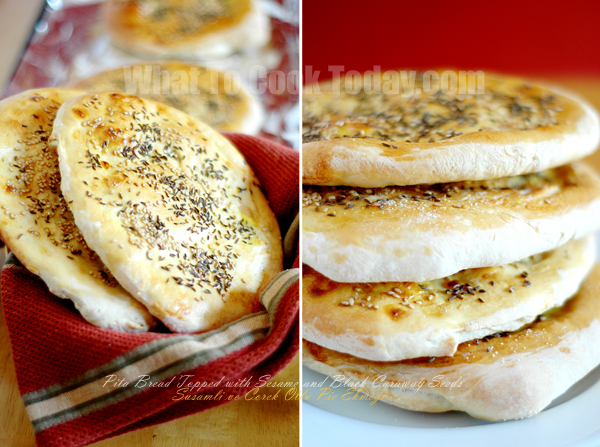This post may contain affiliate links. Please read our disclosure policy.

The day in Turkey starts with bread, and it ends with bread. According to the Sultan’s Kitchen by Ozcan Ozan, many different types of bread were developed during the Ottoman Empire: loaves, flat breads, griddle breads, stuffed breads, and bread rings, called simit, that are dipped into molasses and coated with sesame seeds before they are baked.
People in Turkey purchase their bread from the local bakeries, and wonderful aromas permeate the morning air of villages. Some cooks make their own bread. Pita bread has become common all over the world. Its pocket holds any variety of fillings. But in Turkey, pita bread is cut into chunks and used as a bed for meat dishes.
Ozcan Ozan shared his tips for making good bread:
1. Dust your fingers with flour before you knead dough so it won’t stick to your fingers
2. Knead dough on cool surface, preferably marble or stone and always put it in a warm place to rise
3. Bread bakes best on a pizza stone or tile
This pita bread is much thicker than what you normally will find in the store. It is about 1/2 inch thick with a hard crust along the edge. I love the fragrant nutty flavor from the sesame seeds and caraway seeds. I’m a carb person and that means, I love bread too. I can eat the pita bread just like that without anything 🙂
PITA BREAD WITH SESAME AND BLACK CARAWAY SEEDS/ SUSAMLI VE COREK OTLU PIDE EKMEGI (4 of 8″ pita breads)
1 Tbsp active dry or moist fresh yeast (crumbled)
1 tsp sugar
1 3/4 cups warm water (110 F)
4 cups unbleached all-purpose flour, divided
2 tsp salt
3 egg yolks
1/4 cup milk
1 1/2 Tbsp sesame seeds
1 Tbsp black caraway seeds
Cornmeal, for dusting
COOKING METHOD:
1. In a small bowl, mix together the yeast, sugar, and 1/2 cup of the warm water. Stir and dissolve the yeast well. Let the mixture stand in a warm place for about 10 minutes, until it’s frothy
2. Sift 1 cup of the flour into a large bowl. Add the yeast mixture and stir well. Cover the bowl with plastic wrap and let it rest in a warm place for 30 minutes, until the mixture has the texture of a sponge. Sift the remaining flour onto this mixture. Add the salt and remaining 1 1/4 cups warm water, and stir well
3. Turn out the dough onto a cool, lightly floured work surface (preferable marble), and sprinkle it with flour. Dust your fingers with flour so they won’t stick to the dough, and knead the dough for 10 minutes until it’s firm and not sticky. Place the dough in a lightly oiled bowl and cover the bowl loosely with plastic wrap or a damp cloth. Let it rest for 1 hour, or until the dough doubles in size
4. Heat the oven to 450 F. Place a pizza stone or quarry tile on the middle rack of the oven
5. Turn out the risen dough onto a lightly floured work surface and gently punch out the air and flatten the dough. Form the dough into cylinder, and then cut it into 4 equal pieces with a sharp knife. Shape each piece into a ball, then press each ball with the heel of your palm to flatten it. Cover the dough balls with a damp cloth and let them rest for 20 minutes
6. Use the heel of your palm to flatten each piece of dough some more, and then roll it out into an 8-inch circle, with the outer edge of each round about 1/2 inch thick
7. For the glaze, lightly beat together the egg and the milk. Dip your fingertips into the egg glaze and press it firmly all over each round of dough, dipping your fingertips back into the glaze as necessary. Sprinkle each round with the sesame seeds and the caraway seeds
8. Sprinkle cornmeal over the pizza stone or onto a baker’s peel. Arrange the rounds of dough on the stone and bake the bread in batches for about 10 minutes each batch or until the breads lightly golden on top. Serve warm
NOTE: This dough can be used to make a thinner pita bread with a pocket by rolling it out to 10 inches and baking it as described above. When you take the breads out of the oven, stack them on the counter sideways and upside down, leaning against each other, so they are touching but air flows between them. Cover them with a cloth and let them rest for a few minutes. This allows the bread to soften while the crust stays crispy. To get a pocket, allow the bread to cool completely before cutting it
